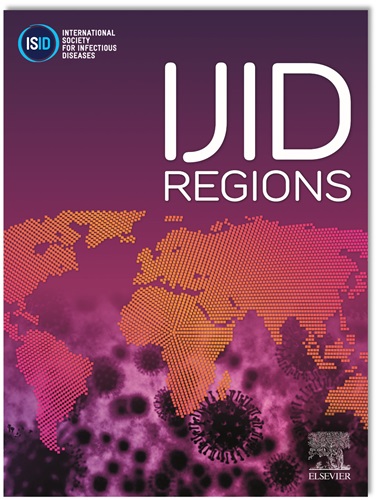Profile of Protective Anti-Hbs Antibodies among Healthy Indian Children and Adults Immunized in Infancy
IF 4.8
2区 医学
Q1 INFECTIOUS DISEASES
引用次数: 0
Abstract
Introduction
Hepatitis-B (HB) virus infection is a serious public health problem worldwide. It's almost 20 years since HB vaccination was first introduced in our National Immunization Schedule (NIS). The study aimed to determine the proportion of subjects in various age groups (children and adults) having anti-Hbs antibody levels in the seroprotective range following early infantile hepatitis-B vaccination.
Material and Methods
In this cross-sectional, observational study, apparently healthy subjects from OPDs of a tertiary care hospital in Northern India, over last one-year were enrolled after taking informed consent. Institute ethics committee clearance was obtained before enrolment. Only those subjects in specified age groups (4-6, 9-12, 16-20 years) were enrolled, who had completed vaccination during infancy, including a minimum of three doses of HB vaccine, and received no other dose of HB vaccination after infancy. Serum samples of subjects were used for measuring anti-Hbs titers (quantitative), anti-Hbc, and HbsAg (qualitative) by standard commercial ELISA kits. Anti-Hbs antibody titers >10 mIU/ml WHO was considered as protective.
Results
A total of 79 subjects (M:F=48:31) were enrolled from three age groups. When tested for anti-HB antibodies in these subjects aged 4-6, 9-12, and 16-20 years, 82.7%, 73.7%, and 55% had antibodies in the protective range, respectively. This gradual decline with increasing age was also noticed in GMTs, which were 33.6, 20.9, and 19.9 mIU/mL, respectively. Out of the total subjects enrolled, 16 (20.2%) developed a subclinical natural infection shown by the presence of anti-HBc antibodies. Despite the decrease in titers of anti-HBs antibodies, such individuals remain protected against clinical illness and chronic HB virus infection upon exposure to the virus, as all of them were negative for HBsAg.
Discussion
Our study shows that quite a good number of subjects developed subclinical natural infection even after primary hepatitis-B vaccination in infancy. All of them were subclinical infections, which the body could clear off, as none was HBsAg positive. Despite the disappearance of anti-HBs, such immunized individuals remain protected against clinical illness and chronic HBV infection upon exposure to the virus.
Experts and most available guidelines stress upon high-risk people (including HCWs) to document postvaccination serological testing of anti-HB antibodies to ensure vaccine uptake. Once they have documented evidence of immunological response to the vaccine, they don't need regular boosters for hepatitis B in the future, even if their protective titers go down, because of immunological memory and the long incubation period of HBV infection.
Conclusions
Infants who received Hepatitis-B vaccination in early infancy, when they become adults, may develop a mild infection when fresh exposure occurs to the virus; however, they remain protected against clinical illness and chronic disease. Therefore, routine boosters are not required for healthy immunocompetent adults.
健康印第安儿童和婴儿期接受免疫接种的成人的保护性抗-Hbs抗体概况
乙型肝炎(HB)病毒感染是世界范围内严重的公共卫生问题。自从乙肝疫苗首次被引入我们的国家免疫计划(NIS)以来,已经将近20年了。该研究旨在确定在早期婴儿乙型肝炎疫苗接种后,不同年龄组(儿童和成人)中抗hbs抗体水平处于血清保护范围的受试者比例。材料和方法在这项横断面观察性研究中,在知情同意后,从印度北部一家三级护理医院的门诊医生中招募了过去一年明显健康的受试者。在入组前获得研究所伦理委员会的许可。仅纳入特定年龄组(4-6岁、9-12岁、16-20岁)的受试者,这些受试者在婴儿期完成了疫苗接种,包括至少三剂乙肝疫苗,并且在婴儿期后未接受其他剂量的乙肝疫苗接种。使用标准商用ELISA试剂盒检测受试者血清样本的抗hbs滴度(定量)、抗hbc和HbsAg(定性)。抗hbs抗体滴度>;10 mIU/ml WHO认为具有保护作用。结果共纳入3个年龄组79例(M:F=48:31)。在4-6岁、9-12岁和16-20岁的受试者中进行抗hb抗体检测时,分别有82.7%、73.7%和55%的抗体处于保护范围。随着年龄的增长,GMTs也逐渐下降,分别为33.6、20.9和19.9 mIU/mL。在所有受试者中,16人(20.2%)出现亚临床自然感染,表现为抗hbc抗体的存在。尽管抗乙型肝炎抗体滴度下降,但这些人在接触病毒后仍然可以预防临床疾病和慢性乙型肝炎病毒感染,因为他们都是HBsAg阴性。我们的研究表明,相当多的受试者在婴儿期接种原发性乙型肝炎疫苗后发生亚临床自然感染。他们都是亚临床感染,身体可以清除,因为没有人是HBsAg阳性。尽管抗乙型肝炎病毒消失,但这些免疫个体在接触病毒后仍然可以预防临床疾病和慢性乙型肝炎病毒感染。专家和大多数现有指南强调高危人群(包括卫生保健工作者)接种疫苗后记录抗hb抗体的血清学检测,以确保疫苗的摄取。一旦他们有证据证明对疫苗有免疫反应,即使他们的保护滴度下降,由于免疫记忆和HBV感染的长潜伏期,他们将来也不需要定期的乙型肝炎增强剂。结论婴幼儿早期接种乙型肝炎疫苗后,成年后再次接触乙肝病毒时可能出现轻度感染;然而,他们仍然受到保护,免受临床疾病和慢性病的侵害。因此,对于健康的免疫功能正常的成年人,常规的增强剂是不需要的。
本文章由计算机程序翻译,如有差异,请以英文原文为准。
求助全文
约1分钟内获得全文
求助全文
来源期刊
CiteScore
18.90
自引率
2.40%
发文量
1020
审稿时长
30 days
期刊介绍:
International Journal of Infectious Diseases (IJID)
Publisher: International Society for Infectious Diseases
Publication Frequency: Monthly
Type: Peer-reviewed, Open Access
Scope:
Publishes original clinical and laboratory-based research.
Reports clinical trials, reviews, and some case reports.
Focuses on epidemiology, clinical diagnosis, treatment, and control of infectious diseases.
Emphasizes diseases common in under-resourced countries.

 求助内容:
求助内容: 应助结果提醒方式:
应助结果提醒方式:


